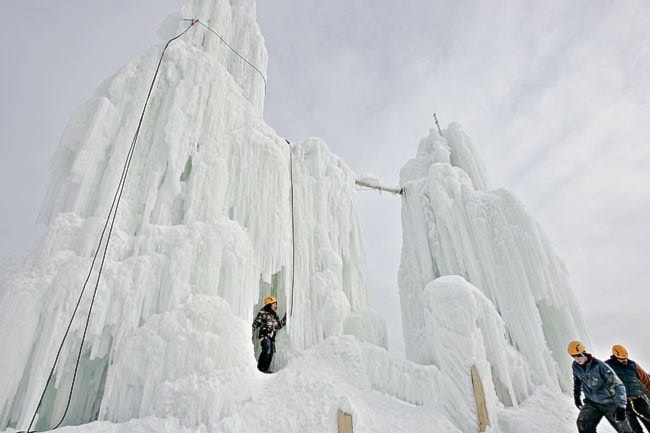Remember when you forgot to turn off the garden hose and it ran for hours?
Chris Gishler purposely lets the water run all winter. The result: a 15-metre tower of ice.
“We’re constantly building,” said Gishler. “Usually the water’s flowing 24 hours a day, seven days a week. We just let it run and run.”
Starting with a tower on his front yard five years ago, Gishler and his team from Equinox Adventure Learning have built numerous towers, including one in Shipyards Park last winter.
“Basically you just leave on the garden hose, but then you have to deal with all the weather changes and the power outages and that sort of stuff,” said Gishler. “We stick a garden hose in the air and then play around with different spray patterns and then you’re very patient.
“Then if everything goes well, in about four weeks you end up with a 30-, 40-, 50-foot high ice tower.”
Gishler’s latest accomplishment can be found at the Takhini Hot Springs outside of Whitehorse, where he also runs a climbing wall and zipline throughout the year. Using about 600,000 litres of water, his team has constructed four connected towers of varying height, the tallest reaching about 15-metres into the air.
Gishler and his team begin the construction process by propping up a water hose about six-metres off the ground and just letting it run. Once they feel they have a large enough base, they work up from there in three-metre intervals.
“You have to build out your base,” said Gishler. “If you get too ambitious and get too high, then you worry about stability issues. We like to sleep well at night, so we build it big at the bottom first.”
Equinox offers daily tours and climbing instruction starting at 1 p.m. However, aside from just climbing the monsters of ice, visitors also get to experience an “ice trek” that allows them to scale from one tower to another.
“The ice trek is unique—there’s nothing else like it,” said Gishler. “It’s based on other activities. In Italy they have these via ferrata, where you go on an extreme hikes where you hike where you normally wouldn’t hike, but you can get there because there’s a safety cable that goes along a cliff. So you attach yourself to the cable and you can basically walk up cliff faces.
“So we took that concept and added it to our ice towers. And we’ve added tunnels and bridges.
“We gear it towards people who have never done it before, who are looking for an adventurous experience. We do the ice trek first and then we’ll try the ice climbing as well. Usually it’s a two- to three-hour program.”
This year’s tower (or towers) took a little longer to form since Gisher and his team were siphoning water from the hot springs, meaning the water took longer to cool and harden into ice.
“It took us an extra month to figure out a cooling system,” said Gishler.
“When we use the hot springs water we get the powder residue from the minerals in the water leaching out. We end up with a wheelbarrow full of chalk.
“It weird because in the hot spring’s pool you end up with an orange residue because there’s iron (in the water.) For some reason on the ice towers there’s the white, chalk powder, which is magnesium and calcium.”
Axes, crampons for your feet, plus harnesses, helmets and all other safety gear are supplied by Equinox. In fact, Gishler, a self-described “gear head,” supplies visitors with state-of-the-art equipment.
“The equipment is fascinating,” said Gishler. “It’s medieval torture equipment meets space age materials.”
Part of what intrigues Gishler so much is the evolution of the equipment over the years.
“The crampons are much better designed now, and the boots,” said Gishler. “In the ‘70s you used to ski in leather boots, now the you have plastic boots with foam and they’re light and strong. The same thing happened in ice climbing.”
The Takhini Hot Springs facilities, which of course include the famous hot springs pool, are open on the weekends and some weekday evenings during the winter months.
“Our primary business is the climbing wall and the zipline,” said Gishler. “We also have a leadership development coarse that we’ve set up around the Hot Springs property.
“I don’t know if you remember the old ParticipACTION Trails, where you’d run along and then you’d stop and there’d be a chin-up bar and that sort of thing.
“We have a similar course set up, but at each station there’s a team building activity that focuses on communication or problem solving or trust.”
Contact Tom Patrick at
tomp@yukon-news.com
